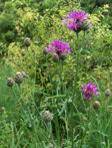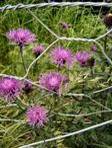| Kingdom | Plantae |
| Division | Magnoliophyta |
| Class | Magnoliopsida |
| Order | Asterales |
| Family | Asteraceae |
| Genus | Centaurea L. |
| Species | scabiosa |
| Binomial name | Centaurea scabiosa |
Other Common Names:
The other common names for this particular herb are Black Knapweed, Churls Head, Greater Knapweed, Hardhead, Ironhead, Hard Irons, Lesser Knapweed, Logger Head, Horse Knops, Matte Felon, Mat Fellon, Bottleweed, Bullweed, Cowede and Boltsede.
History


In the children's TV programme "The Herbs" Constable Knapweed kept law and order in the garden and was often seen with his notebook out. The dried seeds make a great addition to your bird table. In some districts the plant is called from these almost round heads, 'Hardhead,' and the ordinary English name, Knapweed, is based on the same idea, Knap, being a form of Knop, or Knob.
Description
This is a hardy perennial plant which grows upto 1 - 3 ft (30 - 92 cm) high. The whole plant is a dull green, sparingly hairy. The stem is 1 to 3 feet high, generally branched, very tough. The leaves vary in the degree of division and are firm in texture which is deeply cut into, the segments again deeply notched. The lower leaves are very large, often a foot or even more in length, making a striking looking rosette on the ground, from which the flowering stems arise.


Range
It is a native of western Europe especially in England but very in Scotland and Ireland and later introduced in North America where it is considered to be invasive. The species is very common and generally distributed in pastures, borders of fields and roadsides throughout Britain, and flowers from early June till well into September.
Habitat
It is found in pastures, field edges and roadsides, usually on chalk. The plant prefers sandy, medium loamy and heavy clay soils, requires well-drained soil and can grow in nutritionally poor soil. The plant prefers acid, neutral and basic alkaline soils and can grow in very alkaline soil. It cannot grow in the shade. It requires dry or moist soil and can tolerate drought. Thus it prefers meadows cultivated beds.
Cultivation
The seeds are generally sown in early spring in a cold frame and once they become large enough to handle, it is planted into individual pots and plant them out into their permanent positions in the summer. In autumn larger clumps can be replanted direct into their permanent positions, though it is best to pot up smaller clumps and grow them on in a cold frame until they are rooting well. Then it is planted out in the summer or following spring which should be done at least once every three years in order to maintain the vigor of the plant. Basal cuttings are done in spring. Harvest the shoots when they are about 10 - 15cm long with plenty of underground stem. Pot them up into individual pots and keep them in light shade in a cold frame or greenhouse until they are rooting well and finally planted out in the summer. Leaving the seed heads uncut at the end of flowering provides a feast for garden birds.
The roots are dried and seeds are stored in a cool dry place.
Flowering Season
The flowers are generally in bloom between the months of june to september.
Pests and Diseases
Very rarely knapweed becomes host to the parasitic Knapweed broomrape.Members of this genus are rarely if ever troubled by browsing deer.
Parts Used

The most essential parts of the plant which are of medicinal and commercial use are roots and seeds.
Medicinal Applications
• The roots and seeds are diaphoretic, diuretic, tonic and vulnerary.
• It is used as an ointment for treating wounds and skin infections.
• The flowers are used to be eaten for curing digestive disorders and a wound ointment was made from the whole plant.
• It was also used to soothe sore throats and bleeding gums and with pepper for loss of appetite.
• It is also purported to be good to treat catarrh.
• It is often used in dry floral arrangements.
• An important nectar plant for bees and butterflies.


Culpepper tells us: "it is of special use for soreness of throat, swelling of the uvula and jaws, and very good to stay bleeding at the nose and mouth."